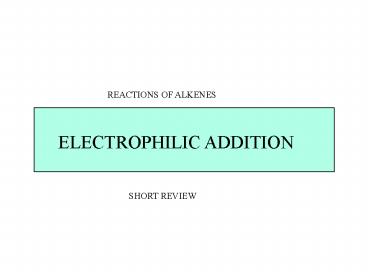REACTIONS OF ALKENES - PowerPoint PPT Presentation
1 / 31
Title:
REACTIONS OF ALKENES
Description:
LEWIS BASE. C. C. H. Cl. Cl. C. C. H. H. C. C. MECHANISM. STEP-BY-STEP ACCOUNT OF WHAT HAPPENS ... C-H s bond help to stabilize. the positive charge of the ... – PowerPoint PPT presentation
Number of Views:36
Avg rating:3.0/5.0
Title: REACTIONS OF ALKENES
1
REACTIONS OF ALKENES
ELECTROPHILIC ADDITION
SHORT REVIEW
2
ADDITION OF
CONCENTRATED HYDROCHLORIC ACID
TO AN ALKENE
H Cl
3
ELECTROPHILIC ADDITION TO DOUBLE BONDS
X
C
C
C
C
EX
E
C
l
conc.
C
C
EXAMPLES
C
C
HCl
H
O
H
H2SO4
H2O
C
C
C
C
H
OSO3H
.
0 oC
H2SO4
C
C
C
C
H
4
MECHANISM
5
CONCENTRATED HYDROCHLORIC ACID
major species present
no HCl
6
ELECTROPHILE
The hydronium ion is an electron-pair
acceptor (Lewis acid) or an ..
ELECTROPHILE
( electon-loving )
LEWIS ACID
(simplified)
The hydronium ion is also a Bronsted acid - a
proton donor.
7
NUCLEOPHILE
Alkenes are electron-pair donors (Lewis bases) or
a
NUCLEOPHILE
( nucleus loving )
LEWIS BASE
.
.
8
MECHANISM
STEP-BY-STEP ACCOUNT OF WHAT HAPPENS
nucleophile
..
..
-
Cl
..
Cl
C
C
C
C
C
C
step 2
step 1
H
H
adduct
H
intermediate
( carbocation )
electrophile
(H3O)
intermediates are formed during a reaction but
are not products
note use of arrows movement of electron pairs
9
MECHANISTIC FAMILIES
We often find that several reactions share the
same basic mechanism.
The addition of HCl to an alkene is an example
of a type of mechanism that is shared by a
number of other reactions.
It is convenient to classify all of these
reactions under the type of mechanism that they
share.
In the current chapter we will study ELECTROPHILIC
ADDITION REACTIONS
10
OTHER ELECTROPHILIC ADDITIONS
GENERALIZED MECHANISM
nucleophile
step 2
step 1
electrophile
intermediate
( carbocation )
OTHER REAGENTS E-X ADD ANALOGOUSLY TO H-Cl
11
REGIOSELECTIVITY
12
THIS IS
A REGIOSELECTIVE REACTION
major
minor
one of the possible products is formed in larger
amounts than the other one
REGIOSELECTIVE
Compare
only one of the possible products is formed
(100).
REGIOSPECIFIC
13
MARKOVNIKOFF RULE
REGIOSELECTIVITY
14
MARKOVNIKOFF RULE
When adding HX to a double bond, the hydrogen of
HX goes to the carbon which already has the most
hydrogens
HCl
..... conversely, the anion X adds to the
most highly substituted carbon ( the carbon
with most alkyl groups attached).
15
SOME ADDITIONAL EXAMPLES
only major product is shown
C
H
C
H
3
3
Cl
l
HCl
C
H
3
C
H
2
C
l
HCl
C
H
C
H
3
C
H
C
H
2
HCl
Cl
16
STABILITY OF CARBOCATIONS
17
THE BEST CARBOCATION FORMS FASTEST
primary
slower
faster
low energy
tertiary
CH3
CH3-CCH2
H3O
major
18
MARKOVNIKOFF RULE
ANOTHER WAY TO STATE THE RULE
When the reaction forms the carbocation
intermediate, the most highly substituted
carbocation is favored.
least favored
methyl carbocation
CH3
primary carbocation
R
CH2
secondary carbocation
R
CH
R
most favored
tertiary carbocation
R
(lowest energy)
C
R
R
19
CARBOCATION STABILITY
HYPERCONJUGATION
H
Electrons in an adjacent C-H s bond help to
stabilize the positive charge of the carbocation
by proximity (overlap).
..
R
C
C
H
R
H
lowest energy
highest energy
lt
lt
tertiary
secondary
primary
20
REACTION PROFILES
21
ACTIVATED COMPLEXES
correspond to transition states for each step
..
-
..
Cl
..
Cl
C
C
C
C
C
C
H
H
intermediate
H
..
d-
d
Cl
C
C
C
C
d
d
H
H
Transition state-2
Transition state-1
show bonds in the process of breaking or forming
ACTIVATED COMPLEXES
(bonds are half formed or half broken)
22
ENERGY PROFILE
two step reaction
intermediate
TS1
TS2
E N E R G Y
Ea2
Ea1
starting material
step 1
step 2
DH
product
TWO STEP
23
RATE-DETERMINING STEP
The slowest step in a reaction sequence. The
reaction cannot proceed faster than its slowest
step.
FIRST STEP IS RATE-DETERMINING
SECOND STEP IS RATE-DETERMINING
24
HOMO and LUMO ORBITALS
FRONTIER MOLECULAR ORBITAL THEORY
25
FRONTIER MOLECULAR ORBITAL THEORY
s CH
2p
s CH
X-
H
When a carbocation reacts, the electrons of the
reacting nucleophile must go into the LUMO
Lowest Unoccupied Molecular Orbital
C
H
H
26
MAPPING ELECTROSTATIC POTENTIAL ONTO A DENSITY
SURFACE (density / elpot)
van der Waals or density surface
a unit charge is moved around the density surface
and the magnitude of its interaction with the
electron density at that point is calculated -
the surface is shaded with colors to
represent the nature and magnitude of these
interactions - red areas have high
electron density (negative charge) and blue
areas have low electron density (positive charge)
neg
methyl carbocation
pos
27
MAPPING THE LUMO ONTO A DENSITY SURFACE
van der Waals (density) surface
( density / LUMO )
methyl cation
Values of the LUMO where it intersects the
density surface are mapped in color.
LUMO
28
EFFECT OF INCREASING SUBSTITUTION ON CARBOCATIONS
( colorations adjusted to the same scale )
density / lumo
density / elpot
CH3
H
CH3-CH2
CH3-C-CH3
CH3-C-CH3
CH3
29
REACTION CARDS
30
Front
Addition Reactions Alkenes, alkynes
Place as much info as you think is important
.. but be concise.
Chap 8
p. xxx
Back
Electrophilic addition to CC
( Hydrohalogenation )
Regioselective reaction
follows Markovnikoff Rule
Reaction Card (3x5 index)
major
minor
HCl, HBr (peroxide free) and HI work
Most of this information can be abstracted from
the end of the chapter reviews.
show mechanism here
...next slide
Carry cards with you and study them in spare
moments.
! Best carbocation is formed !
31
nucleophile
..
..
-
Cl
..
Cl
R
R
R
C
C
C
C
C
C
step 2
step 1
H
H
alkyl halide ( adduct )
H
intermediate
( best carbocation )
electrophile
(H3O)































